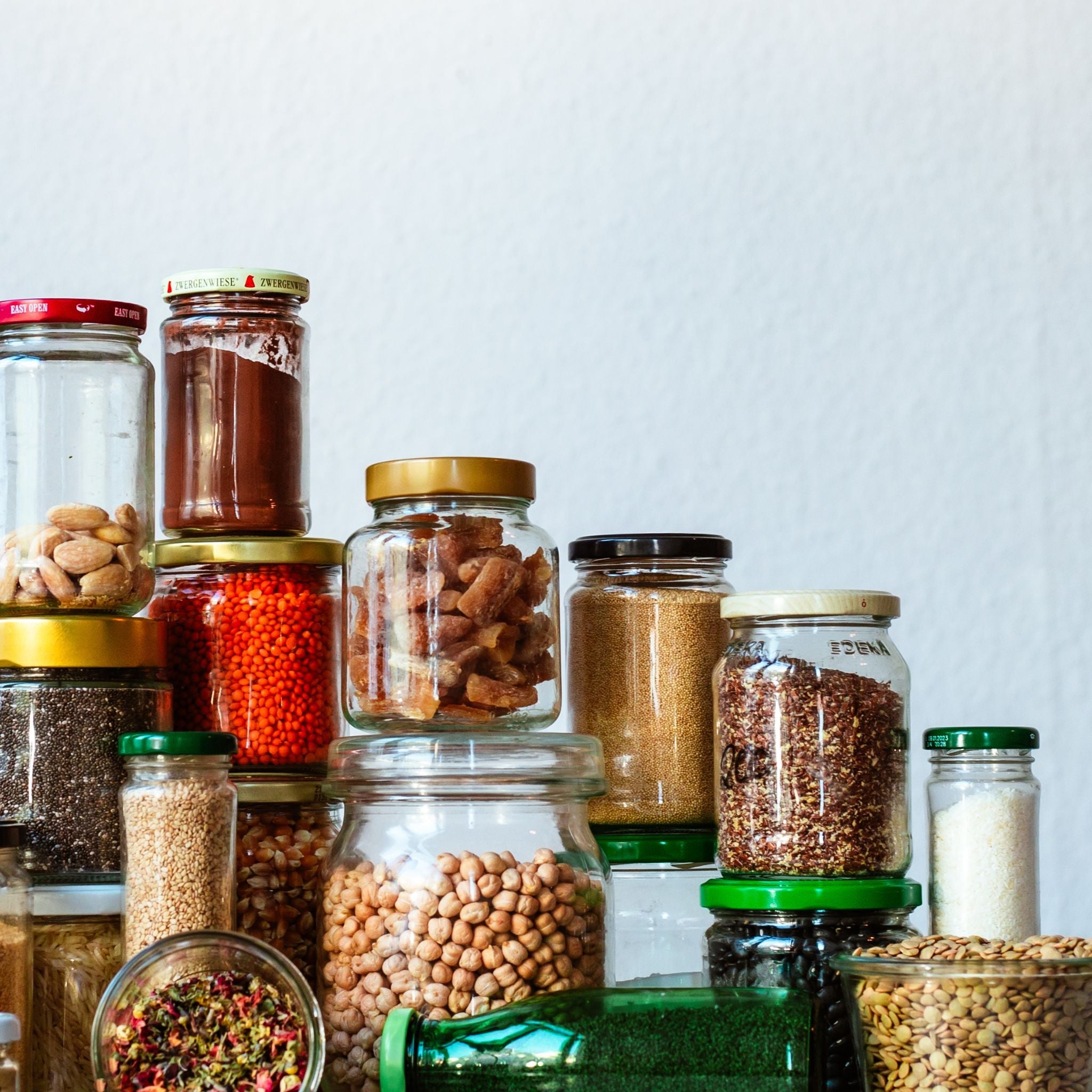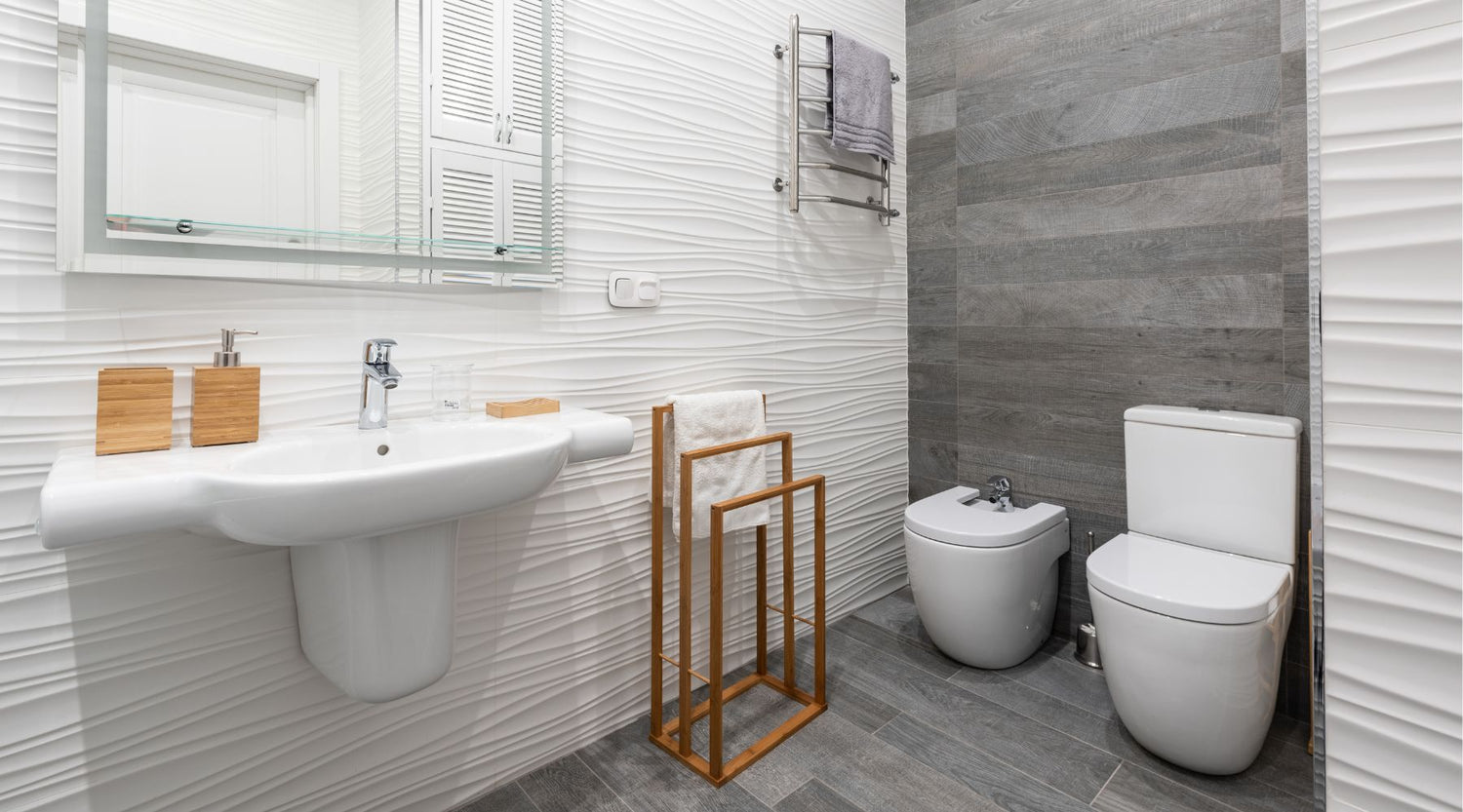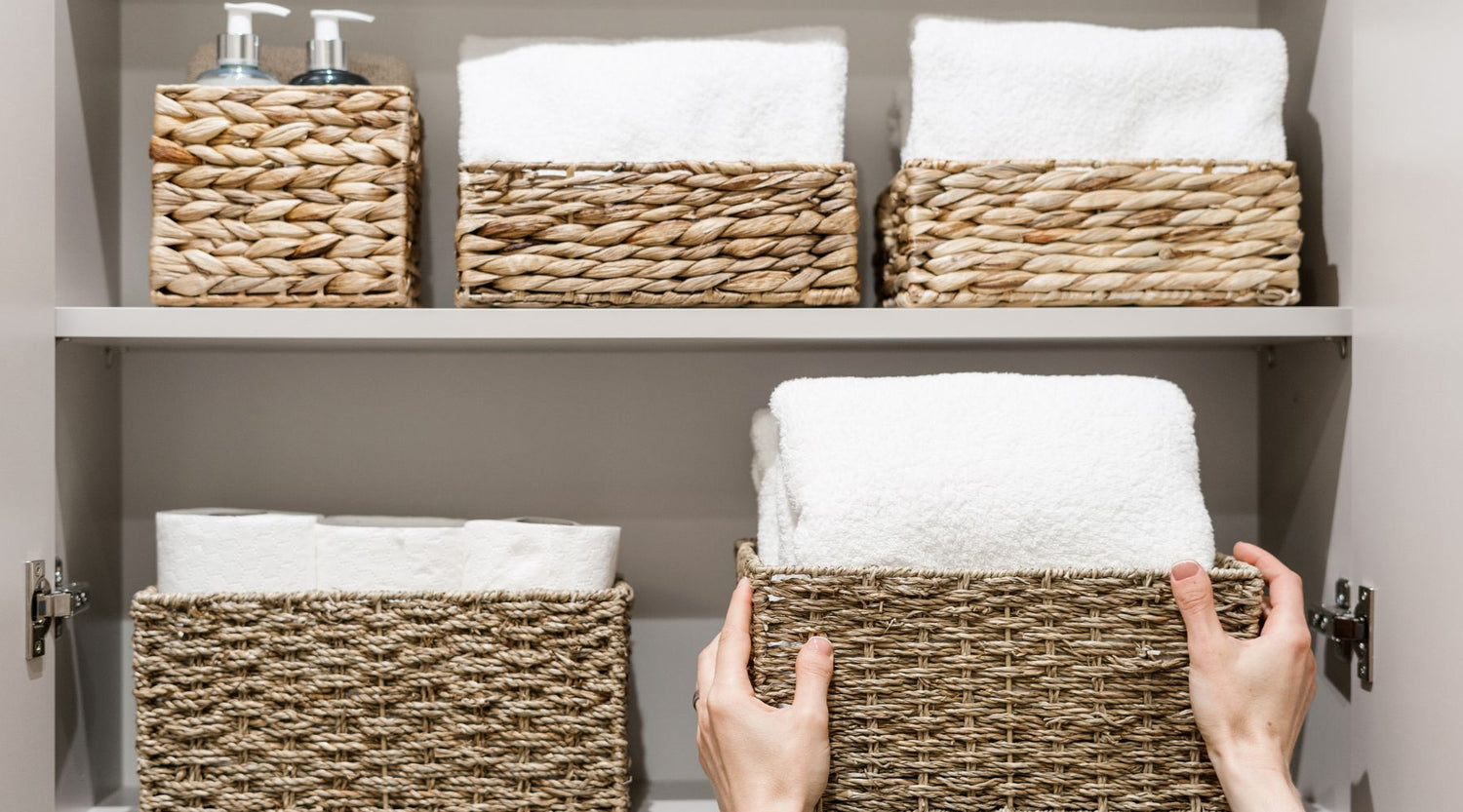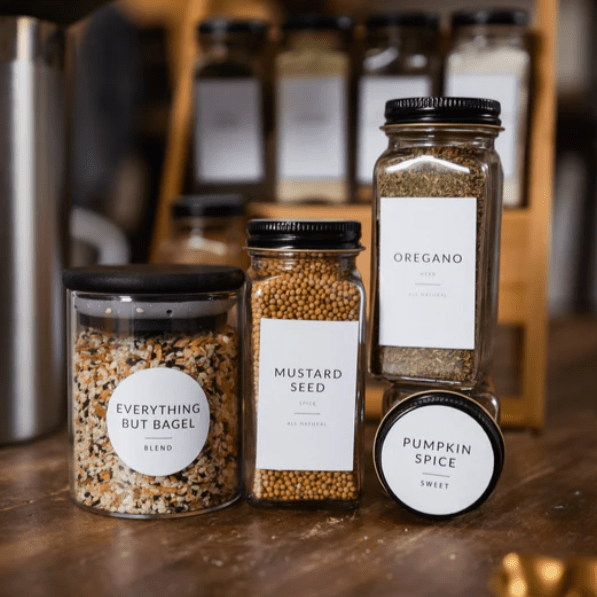Achieve organization in pantries of all shapes and sizes with a strategic combination of organizational tools and strategies. Here are 10 of our favorite pantry organization ideas for you to take advantage of.
Quick links:
Grab a set of our convenient pantry labels to streamline your pantry storage.
Group like items
Organize your pantry by grouping similar items together in designated areas. Keep all baking supplies—flour, sugar, baking powder, and spices on one or two shelves. This way, everything you need to bake is in one spot.
Assign another shelf for snacks such as granola bars, chip bags, pretzels, and crackers. Use clear plastic bins to easily see contents without shuffling through packages.
Do the same with canned goods, group them in one area alphabetically or by food type (e.g. soups, vegetables, beans, etc..) Keep your most used categories near eye level for easy access.
Grouped-like items will make recipe preparation much easier and faster. It also helps identify which items need to be used up or restocked.
Divide shelves
Dividers on pantry shelves separate categories and bring order. Here’s what you can try:
- Use vertical dividers to segment shelves by ingredient type (oils, canned goods, grains).
- Try horizontal dividers to create compartments for smaller items that can get lost (spices, packets, etc.).
- Acrylic or wire dividers neatly group similar products. They come in various heights and configurations to suit your storage needs.
- Custom-built wood dividers offer sturdy partitioning solutions and provide a built-in look.
Clearly designated shelf spaces make locating things effortless. Dividers also stop items from getting displaced, damaged, or tipping over.
Label containers
Labeling systems offer many benefits for organizing your pantry. Some of our favorite ways to use labels include:
- Label food categories such as snacks, baking ingredients, canned goods, etc. to easily find items.
- Use color-coded labels to quickly identify certain types of foods (red for spicy, green for healthy, etc.).
- Label expiration dates so you know what needs to be used up soon
- Label specialty diet items such as gluten-free and dairy-free.
- Use creative or fun labels to make your pantry look cool while helping you find food faster.
- Use our chalkboard labels to organize your pantry staples and make label changes as needed.
- Label leftovers stored in your pantry with reheating instructions.
- Use preprinted pantry organization labels to save time and effort.
Our minimalist pantry label set comes with 179 preprinted labels. These amazing labels are suitable for rectangle, square, and round food containers. They cover all of the main food categories.
Spin lazy Susans
Lazy Susans are revolving trays perfect for optimizing corner cabinets and maximizing space in round shelving. Some of the best ways to utilize lazy Susans include:
- Install a lazy Susan in otherwise unused corners to effectively use the space for smaller items like spices and packets.
- Stack multiple lazy Susans to maximize storage capacity. Use risers underneath to add even more storage space.
- Store similar pantry items on each tier for easy access. For example, keep dry ingredients on one tier, and pantry staples on another.
- Use locking lazy Susans to prevent items from falling when kids access the pantry.
- Choose a sturdy, full-circle lazy Susan to hold heavier jars and cans without sagging over time.
- Consider using non-slip liners or securing items in mini trays or bins so items don't shift.
- Install lazy Susans on existing round shelves or buy shelving units with lazy Susans already built in.
Stack bins
Vertically stacking storage bins is an excellent way to get extra pantry space. Stackable bin ideas include:
- Stack glass containers of uniform size to optimize vertical real estate and corral loose ingredients.
- Use clear stackable bins to easily identify contents instead of opaque containers that hide what's inside.
- Install shelf risers to raise bins and make room for another row underneath. This effectively doubles the storage capacity of a pantry space.
- Purchase bins with interchangeable inserts to customize interior divisions for different item categories.
- Choose stackable bins with ventilation holes to store onions and other produce that need proper air circulation.
- Stagger stack orientations front-to-back to provide better visibility and access instead of stacking bins directly on top of each other.
- Use open wire bins for visibility while neatly corralling bags and boxes.
Hang storage
Hanging storage offers a convenient way to optimize vertical real estate while items are visible and within arm's reach. Wall-mounted racks, hanging shelves, and over-the-door storage provide additional capacity without occupying precious floor space.
Door-mounted canvas bins are ideal for storing bulk items such as onions and potatoes. Bins allow air circulation to prevent spoiling. Sturdy metal utility hooks installed on walls or the back of cabinet doors can hold lighter items such as small spice packets that would otherwise get lost in drawers.
Wire shelving with adjustable tiers can fit various taller ingredient jars and boxes that usually claim a lot of shelf space. Vertical space adjacent to the pantry like the inside of a closet can be utilized for installing full-height storage systems with shelves and cabinets. This creates annexed storage that acts as an extension of the main pantry.
Use risers
Smart ways to incorporate risers into your pantry include:
- Install risers underneath existing shelves to instantly increase storage capacity. The added tiers let you organize more items without taking up additional floor space.
- Use risers under stackable containers to gain a whole extra row of storage bins. Choose risers tall enough to accommodate most container heights.
- Opt for sturdy, solid, medium-density fiberboard (MDF) or metal risers over plastic risers that can bend and break under heavier loads.
- Purchase adjustable risers that can be set to custom heights to accommodate different sizes of jars, cans, and boxes on each tier.
- Choose riser heights that lift items to ergonomic levels. This prevents the need to constantly bend down to access frequently used ingredients.
- Use multi-level risers with built-in shelf dividers to neatly organize smaller goods that would otherwise clutter one big open shelf.
Maximize every inch
Here are some great ideas you can use to create extra storage in your pantry space:
- Consider floor-to-ceiling shelving systems with adjustable tiers to fully optimize height, especially if you have tall ceilings. Remove soffits first if they limit overhead space.
- Mount wall racks or wire storage bins for bulky items such as bags and boxes. This utilizes air space instead of taking up prime-shelf real estate.
- Add slide-out shelves to easily access items located towards the back of lower cabinets. Full extension slides bring contents forward within arm's reach.
- Fill awkward narrow gaps with custom inserts to neatly store smaller goods. Take advantage of wasted space above the pantry entrance by mounting overhead storage.
- Transform difficult angles and dimensions into functional storage space with smart built-outs that are tailored to the area. Customized solutions cater to often neglected or inefficient areas.
Organize by category

Keep your pantry in order by organizing ingredients and foods into designated categories. Helpful tips include:
- Group together shelf-stable items that fall within the same food category such as dry foods, snacks, canned vegetables, baking necessities, favorite beverages, etc. Assign each group their shelf, bin, or section.
- Use dividing shelves, bins, and food storage containers to neatly separate and define ingredient categories within shared storage areas. This keeps similar items clustered together and distinctly separated from other item types.
- Label shelves, bins, and hooks with category names such as "baking goods" or "canned fruits and veggies."
- Arrange items within categories alphabetically so ingredients are easy to find. Or order them rotationally with newer items at the back to promote first-in, first-out stock rotation.
- As you put newly purchased groceries away, make a point to return items to their designated area.
Attach a chalkboard
Attach a chalkboard to your pantry door or an inner wall to create a handy space to jot notes about grocery items that need to be purchased. This visual reminder makes grocery shopping efficient and helps prevent multiple trips to restock forgotten ingredients.
When inspiration strikes for a certain recipe but you lack key components, quickly scrawl the items needed on your pantry chalkboard. The list stays visible, allowing all family members to update it as they notice stock running low.
Chalkboards also offer an element of decorative appeal when they are not being used. Choose framed boards with a classic black slate look, or more colorful options like red and green to brighten up your pantry. Printed chalkboard contact paper provides an affordable and removable alternative to installed chalkboard.
Keep frequently used chalk or liquid chalk markers handy by mounting a ledge below the board to neatly store writing utensils. Magnetic versions are also handy for temporarily adhering to a printed list from the fridge or holding up recipes with a magnetic clip.
With an easy-access chalkboard installed, you will save yourself extra trips to the store to restock forgotten pantry items. Your custom grocery list ensures that you will always have everything you need to cook your favorite meals.
Pantry organization ideas FAQ
What are some great small pantry storage ideas?
For small, cramped pantries, make the most of vertical storage with pull-out shelves, over-the-door canvas bins, and hanging racks to neatly corral bulk goods up and out of the way. Multi-tiered racks double capacity in tight footprints. Turntable lazy Susans in corners also help maximize every inch of round shelving.
How do I organize my walk-in pantry?
A walk-in pantry can be a perfect place to store all of your kitchen supplies, but it is important to maximize only if you get the best out of its potential. Here are some steps you can follow to organize your walk-in pantry:
- Conduct an inventory check before creating an organizational plan. Group similar food items together—paper products on one shelf, baking essentials on another, cereal boxes, and grains in labeled pantry containers on another.
- Use shelf risers, adjustable drawers, and storage bins to effectively use the vertical storage potential. No more frustrating dead space in hard-to-access areas.
- Strategically place everyday staples on easy-to-reach shelves at eye level or in slide-out cabinets. Reserve upper levels and deep cabinetry for overflow stock and rarely used items.
- Label shelves clearly for easy identification of categories such as spices, canned vegetables, snack foods, etc.
What are some good DIY pantry storage ideas?
DIY pantry storage ideas include:
- Upright soda can organizers to neatly file spice jars
- Wall-mounted wooden crates for vertical partitioning
- Hanging cabinet doors as racks for bulk ingredient bins
- Plastic rain gutters for vertical baking sheet storage
- Repurposed cardboard boxes covered in gift wrap as custom drawer dividers
- Pegboard walls with hooks to neatly group ingredients
- Tension rods with closet organizers for additional shelving area
- Contact paper to transform the appearance of existing containers
How do I organize my pantry without baskets?
To organize your pantry without baskets you can separate ingredients in labeled glass jars, stacking smaller items in front. Install shelving dividers or pegboard walls with hooks to neatly group goods. Designate shelf areas by category using contact or washi tape borders. Store loose bulk items together in reusable fabric bags clipped onto hooks.
What do you put on the floor of a pantry?
The floor of a pantry is great for larger, heavier items that would be difficult to lift onto shelves. Items typically placed on the pantry floor include big bags of pet food, bottled water and soda packs, pack 'n plays, cleaning buckets, brooms, mops, and clunky kitchen appliances like stand mixers and spare microwaves.
How do I lay out my pantry?
When laying out pantry space, reserve lower shelves for the heaviest ingredients such as canned goods and large bags to minimize lifting. Medium-height shelves work well for staples such as baking essentials, pasta, and grains. Top shelves can store less-used extras, overflow stock, small appliances, and serving items. Place your kids’ favorite snacks within reach. Keep cleaning items separate from food storage.
Where should a pantry be placed in the kitchen?
For convenient access while cooking, locate pantries next to frequent food prep zones such as kitchen islands and countertops so ingredients are close at hand. Adjacency to the fridge facilitates seamless grocery unloading. Don't position the pantry beside hot ovens or stoves, as this could slowly compromise food freshness over time.
How can I organize my pantry for cheap?
Organize your pantry for cheap with repurposed materials such as egg crates or recycled food boxes, and separate ingredients by category or expiration date. Use masking tape and acrylic containers from a dollar store to neatly label and divide shelves. Mount tension rods or boards across existing shelving to double up on storage space.
Is the pantry organization worth it?
Yes, the pantry organization is definitely worth it. An organized pantry saves time by eliminating the frustration of shuffling items and searching for ingredients. Properly labeled storage ensures first-in, first-out rotation so that nothing is left to spoil, and also allows you to be aware of exactly what items are on hand.
How often should you organize your pantry?
It is a good idea to thoroughly organize your pantry two to three times per year. Each time you should check expiration dates, consolidate opened packages and boxes, remove expired items, and donate unopened nonperishables that are over 12 months old. Maintain tidiness with weekly organizational touch ups as you restock groceries.
Where is the best place to store my spices and seasonings?
The best place to keep your spices and seasonings is in a pantry or kitchen cabinet that maintains a cool temperature while staying protected from direct sunlight and moisture. All spices and seasonings should be stored in airtight containers to maintain freshness.






